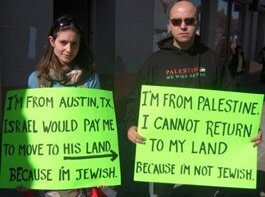A young student deported from the West Bank to Gaza is just the latest victim of Israeli efforts to sever ties between the territories.
UPDATE: New York Times (12 Nov 2009): Expelled West Bank Student Petitions Israel Court. The court… remanded the case to a military hearing to be held at the Gaza border next week, where Azzam can attend. ”My priority, what’s most important, is to get back to my studies,” Azzam said, speaking by phone from Gaza. ”I was so close to finishing, I just want to get back to Bethlehem and finish.”
By Ben White, The Guardian – 12 Nov 2009
www.guardian.co.uk/commentisfree/2009/nov/12/palestinian-land-west-bank-gaza
Twenty-one-year-old Palestinian student Berlanty Azzam was seized by Israeli soldiers at a checkpoint in the West Bank last month. Bound and blindfolded, she was forcibly deported to the Gaza Strip. Berlanty was in her final semester at Bethlehem University in the West Bank, and was returning from a job interview in Ramallah.
The problem was that she had an ID card registered in Gaza, and the Israeli occupation, in the words of the human rights organisation, B’tselem, “almost completely forbids the movement of Palestinians between the West Bank and the Gaza Strip”.
Bethlehem university has had “continuous problems” getting Gaza students the requisite permission from Israel, according to communications officer Stephanie Rhodes.
“We are a Palestinian university and these are Palestinian students. The West Bank and Gaza Strip are supposed to be treated as one territorial unit, but that’s not what’s happening.”
Rhodes was referring to how Israel’s division of the Palestinian territories goes against its own recognition of the Gaza Strip and the West Bank as “a single territorial unit” in previous agreements. This was also affirmed by the Israeli supreme court in 2002 as part of a justification for the expulsion of Palestinians from the West Bank to Gaza. The court ruled that this did not violate international law because the two areas “should be regarded as one territory”.
Restricting Palestinian students’ freedom of movement has been just one element of Israeli measures that deepen the separation between the Gaza and the West Bank. While the bitter split between Fatah and Hamas has led some to talk about two different Palestinian “states”, the physical division is one that Israel has created over a number of years.
From the start of the second intifada in 2000 to 2005, “travel from the Gaza Strip to the West Bank declined by 98%”. This restriction was imposed in the name of security, though in most cases where there was an appeal, the decision to deny a permit was reversed. But the “disengagement plan” in summer 2005 marked a real sea change.
To understand why Israel’s policy towards severing ties between Gaza and the West Bank became more formalised and political post-disengagement, it is necessary to recall the reasons for this strategic redeployment in the first place.
First, the withdrawal was aimed at freezing the peace process, preventing Palestinian statehood. In the words of a senior adviser to then prime minister Ariel Sharon, disengagement from Gaza supplied “the amount of formaldehyde that’s necessary so that there will not be a political process with the Palestinians”.
The second strategic aim was to consolidate the colonisation of the West Bank. Sharon told the Knesset that “whoever wishes to preserve the large Israeli settlement blocs under our control forever … must support the disengagement plan”. Taking settlers out of Gaza, he affirmed, meant that Israel could focus its “efforts” on areas like “Greater Jerusalem” and the “settlement blocs”.
This is the context in which to understand how Israel has sought to tear up the Oslo commitment to keeping Gaza and the West Bank as “one territorial unit”. In May 2007, before Hamas took control of the Gaza Strip, the minister for strategic affairs (now foreign minister) Avigdor Lieberman presented a plan for “isolating the Strip from the West Bank” and considering them as “two separate entities”.
The “practical steps” suggested included “no movement between Gaza and the West Bank, not of goods, and not of people”. Gaza was to be defined as “a hostile independent political entity”, a designation confirmed later in the year, after Hamas defeated Fatah in the Palestinian elections (though in the initial aftermath of the elections, the whole Palestinian Authority was considered a “hostile entity”).
While pointing out that the permit system and movement restrictions go back to 1991, Joel Greenberg, from HaMoked, believes current policies are rooted in Israeli strategy since the redeployment in 2005, when “Israel said it was no longer occupying the Gaza Strip”. Thus preventing movement and transferring residency status “stems from that approach” of treating Gaza differently to the West Bank.
According to the Israeli human rights group, Gisha, measures like controlling the “population registry” and “preventing civilians from changing their place of residence” are a result of Israel “pursuing political goals at the expense of the civilian population” (using the “vague pretext” of “responding to the security-political situation in the Gaza Strip”).
Gisha spokesperson Keren Tamir told me it is aware of six Palestinians who have been stopped at the same checkpoint in the last few weeks. Tamir described how Israel has been forcibly deporting Palestinians from the West Bank no matter how long they have been resident there: “We are talking about people with businesses, families – their whole lives.”
Israel’s efforts to sever links between Gaza and the West Bank are also being replicated in the West Bank itself, with the fragmenting of Palestinian territory there. Restrictions on access based on residency location have been used, for example, in the Jordan Valley.
In 2004, before the disengagement from Gaza, the World Bank stressed that “an unfettered flow of people and goods between Gaza and the West Bank is needed to link the two territorial elements of the Palestinian economy, and to lay the basis for viable statehood”. By 2007, the warning was clear – the division would likely “undermine international efforts to establish a Palestinian state” and erode “the consensus around the idea of the two-state solution”.
There is, therefore, a strategic continuity between Sharon’s aim with the disengagement to “kill the possibility of a negotiated peace” in exchange for imposing an “emasculated and semi-autonomous Palestinian homeland” on Israel’s terms, and the Binyamin Netanyahu/Lieberman vision of an “economic peace”.
Severing ties between Gaza and the West Bank is part of a deliberate fragmentation policy that not only defies international law and human rights, but is also designed to render genuine Palestinian independence and self-determination impossible




















